Next weekend the Austrian Bundesliga will return from the winter break and the matches of the 19th matchday will take place. However, within the last three days, the four quarter-finals of the OFB Cup took place. Ahead of the most interesting match of this round, LASK Linz vs Sturm Graz, two other games took place and both times a team from the second division was able to defeat a club from the Austrian Bundesliga. After this game, RB Salzburg was in the fourth game of the quarterfinals able to go through and so, LASK and Salzburg will face each other in the semi-finals of the ÖFB Cup.
LASK against Sturm Graz was the only matchup of all four quarterfinals between two teams from the highest Austrian league. Due to that, everyone expected that this game would be competitive and interesting to watch. However, Graz showed not a good performance while Linz tried to get the control of the game but it never worked off perfectly. Due to that, we didn’t see much goalscoring chances (both teams’ xG value was lower than one), but in the end, Linz were able to get through to the semi-finals with a 2:0 victory at home.
In this tactical analysis, we’ll look at both teams’ tactics and examine why LASK could score the two deciding goals which brought them the victory over a weak team of Graz.
Line-ups
Valérien Ismaël had to rotate a bit due to some injuries but stayed with his usual 3-4-3 formation. The 37-years-old Thomas Gebauer was between the sticks for Linz since the usual keeper Alexander Schlager is currently injured. The back three was made of the captain Gernot Trauner, Philipp Wiesinger and Reinhold Ranftl who usually plays as a right wing-back.
Stefan Haudum replaced the injured Peter Michorl and joined James Holland in the central midfield. The wing-backs were René Renner and Mavrin Potzmann. Klauss was the central striker while he was upfront supported by the two wingers Thomas Goiginger and Dominik Frieser.
On the other side, Strum’s head coach Nestor El Maestro also chose the 3-4-3 formation with Jörg Siebenhandl in goal. The back three in front of him consisted of Anastasios Avlonitis, Lukas Spendlhofer and Ivan Ljubic. The wings were occupied by captain Stefan Hierländer and Emanuel Sakic. Otar Kiteishvili and Juan Domínguez were the two central midfielders. Thorsten Röcher, Bekim Balaj and Philipp Huspek were the three men up front.
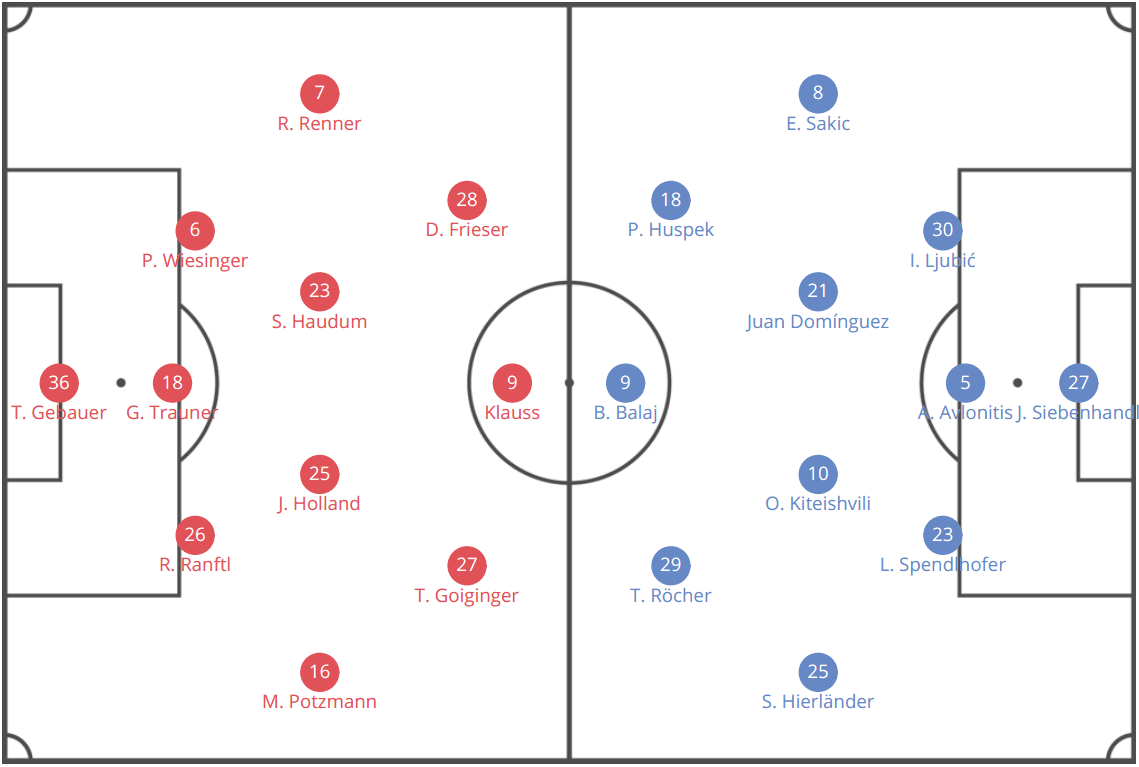
LASK dominating the game
As already mentioned, none of the two teams really showed a good performance in this game, but LASK were still clearly better. As we’ll see later in this tactical analysis, Graz didn’t even try to have a structured build-up. Ismaël’s squad wanted to build-up the attacks from the back with short passes but it also didn’t work off that good. One deciding factor was that none of the two teams had ever periods where they were able to stay in possession for a long time as their values for average possession duration tell with 10 seconds and nine seconds respectively. This was especially since there were so many fouls in this match (33) and due to that, neither team could keep the ball for a long period.
Anyways, Graz concentrated on the defending and hoped that they would score this one deciding goal after a long ball as we’ll see later when we look at their tactics in possession. When LASK were on the ball, Sturm created mostly a 5-4-1 as the wing-backs dropped deeper to create a back five while the wingers positioned themselves on the same height as the central midfielders and Balaj stayed alone upfront. They rarely used a high pressing but stayed deeper to stay compact and don’t give away any free spaces. In the shot below, we can see Graz’s 5-4-1 out of possession.
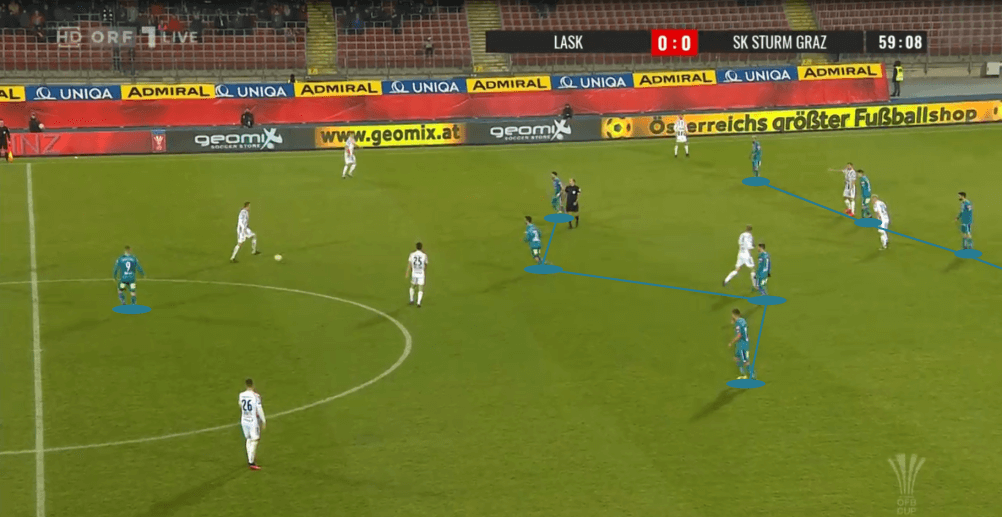
So, since Sturm didn’t want to be in possession, they let LASK have their build-up and sit back deeper. However, they defended not well, and Linz were several times able to break up the defence of Graz. They often reached the final third but had a hard time getting into dangerous situations. However, Especially the central man of the back three and captain Trauner once more proved that he’s able to play penetrating vertical passes to beat the midfield line of the opposition. He showed that already several times in this season and in this game once more.
When Linz were in possession of the ball, the three centre backs positioned a bit wider while the wingbacks stayed near the touchline. The three upfront rotated quite a lot and also sometimes dropped deeper, so in general, they didn’t have certain areas where they had to position themselves during the periods of possession. Meanwhile, the two central midfielders, Holland and Haudum were positioned in the half-spaces and tried to provide vertical passing options for the three defenders as we can see in the example below. In this situation, Trauner found Haudum with a good vertical pass and bet the midfield four of Graz. The two central midfielders are positioned in the half-spaces and highlighted.
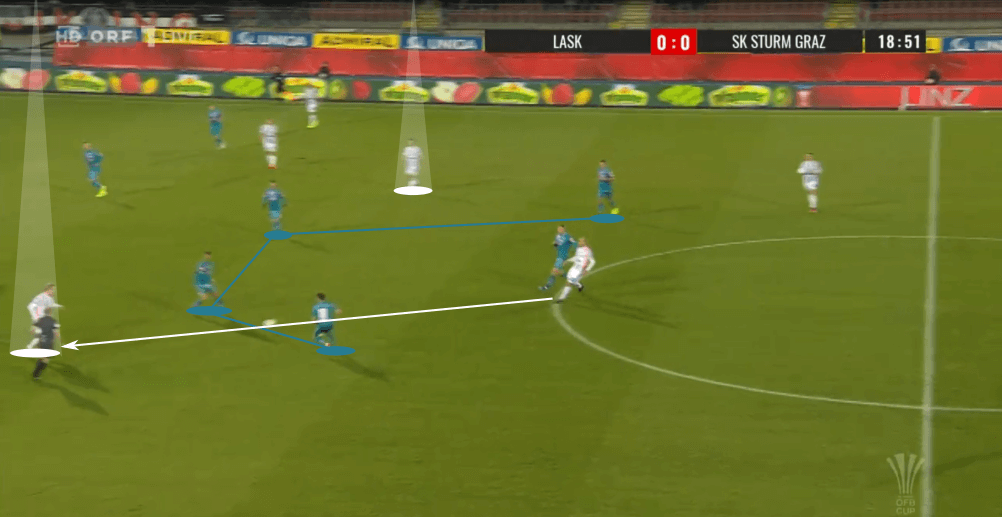
In general, the majority of LASK’s attack either came through the centre or over the left-wing. Renner received clearly more passes than Potzmann. Besides, Linz often tried to bring Renner into one-on-one situations against the right wing-back Sakic. Considering this, they often used such vertical passes as in the image above to find Haudum who then passed the ball to Renner to bring him into an isolated challenge against Sakic as it can be seen in the situation below.
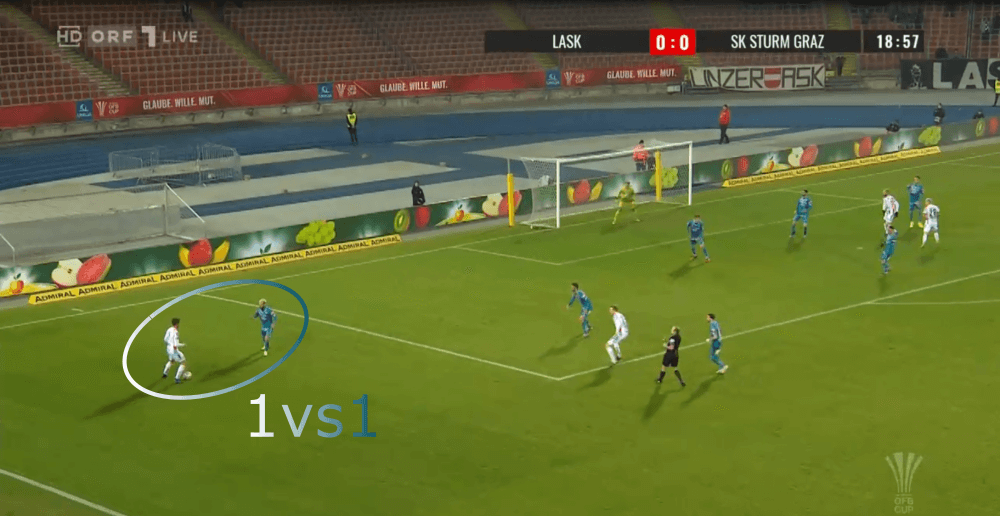
Anyways, Linz was also quite harmless and almost never created really dangerous goalscoring chances. Besides, the 2:0 was scored in the injury time as we’ll see later in this tactical analysis and until then it was quite thrilling as LASK were just with one goal ahead. This one goal resulted out of a successful counter-pressing by Linz and then two of their best offensive players, Goiginger and Klauss, showed their individual class. Since Ismaël’s team won back the ball just moments earlier due to a good counter-pressing, none of Graz’s defenders were near the central forward Klauss who utilized that with an intelligent run as he stayed between the two defenders and Goiginger delivered a perfect cross which the striker then converted into a goal with a great header to score the opening goal of this match.
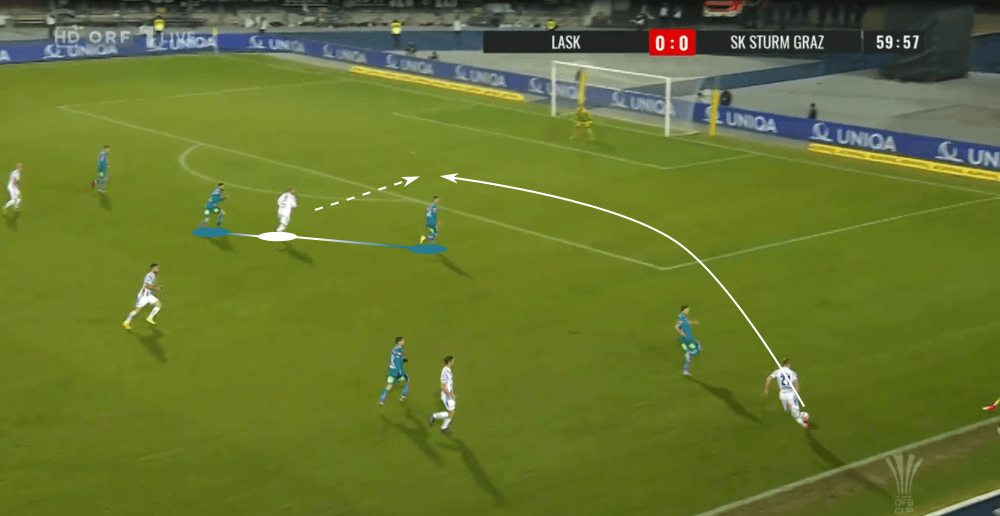
Graz are harmless and Linz’s press
As already mentioned, Graz mainly focused on defending in the low or mid-block and hoped that they would score a goal after a long ball as they mainly operated with them. We rarely saw that El Maestro’s team tried to use combinations of short passes to progress the ball further up the pitch. Instead, the permanently used long balls which rarely led to anything as their xG-value shows with 0.24.
However, you have to give credit to Linz who used a high pressing and a counter-pressing which made it extremely hard for the opposition as we can see below. Their PPDA (passes per defensive action) value was after the 90 minutes 5.1.
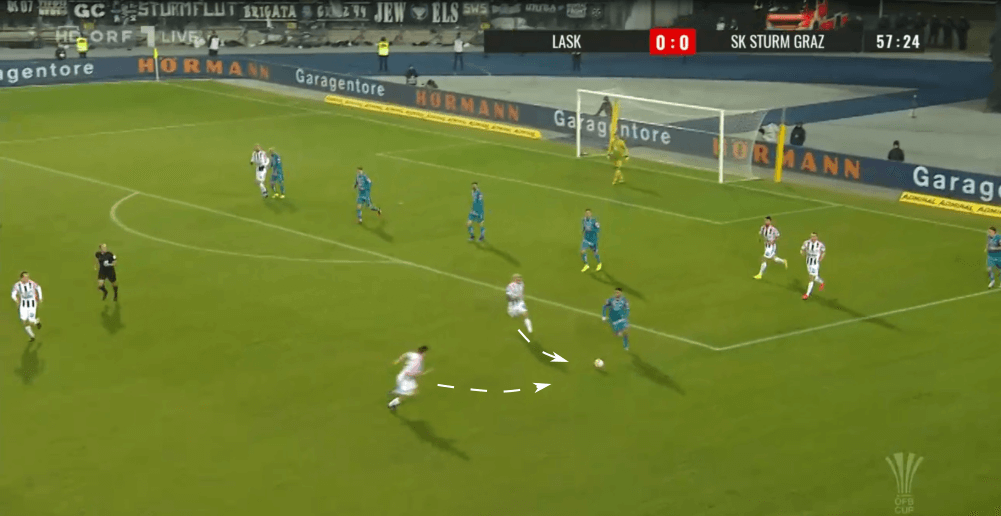
But when you put pressure on your opponents so high up the pitch, you must have defenders in your squad who are brave enough to also push forward and keep the vertical compactness alive. Ranftl, Trauner and Wiesinger did so and pushed forward during the high pressing. Also, in the moments in which they operated with a counter-pressing the back three stayed high as they were already positioned about the half-way line during their own periods of possession. Notice in the example below the positions of the three defenders.
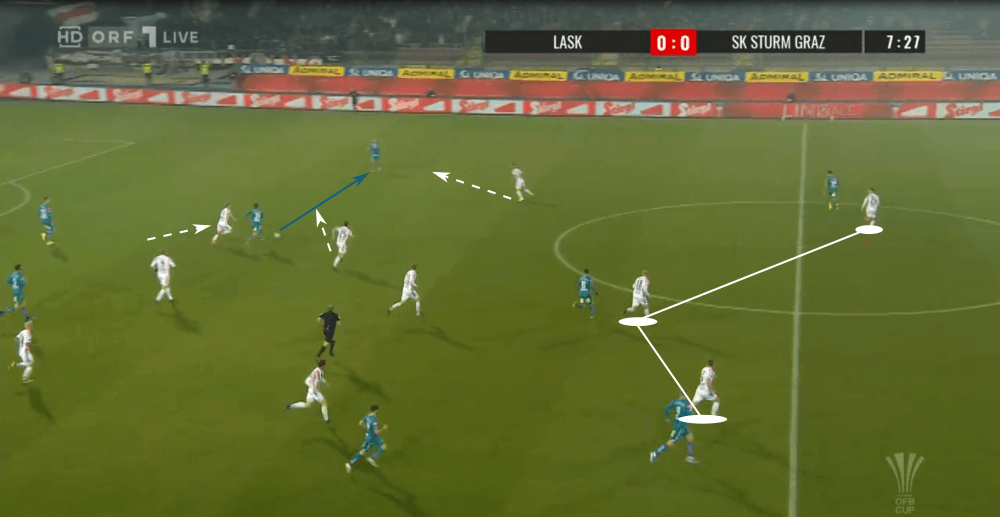
Whenever Sturm was in possession, we saw a bit of a similar formation as when Linz were on the ball as they also positioned themselves in 3-4-3 and the three forwards had quite a lot of freedom. However, the big difference was that Graz’s back three and also the two wing-backs stayed extremely narrow. Due to that, it was easy for LASK to mark the opponents and stay horizontal compact at the same time. So, notice in the situation below how far away Sturm’s wing-backs are from the touchline and the three defenders are also close to each other. Linz logically also stays compact and due to that, there is absolutely no free space in the centre and Graz have to play the long ball. So, in the hot below the white area should show how little space Graz used and made it hard for themselves to have short passing options.
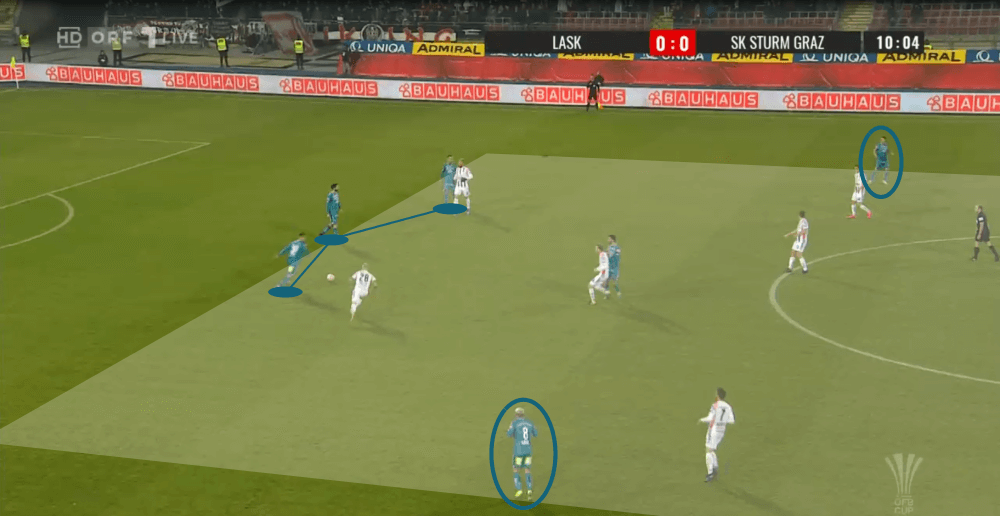
However, it was not the case that Graz wanted to play short passes during the build-up and they didn’t have the space for that due to their own positioning. No, they permanently operated with long balls and due to that, they positioned narrow to have enough men in the central areas to either win the second ball or already stay horizontal compact if they lose the ball. In the shot below, we see a very interesting situation as Graz have a freekick at about the half-way line. The left player of the back three Spendlhofer goes wide to get ready for the build-up since such a freekick can be a perfect situation to calm down the game and start a new period of possession. However, all other players get ready for the long ball and Ljubic also then plays the long pass forward instead of playing it short.
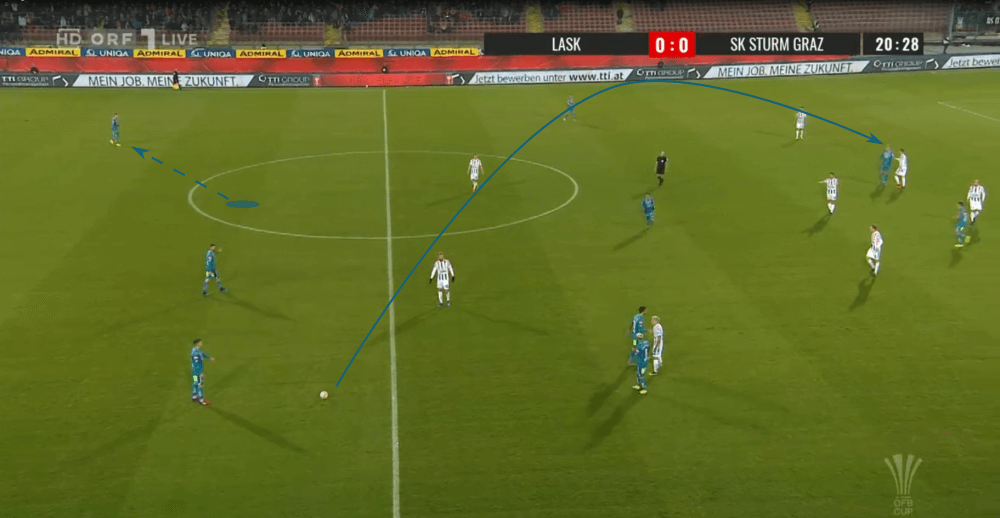
Anyways, the bad thing for Graz was that these long balls didn’t work off at all. Their greatest chance of this match was a goal which got disallowed because of an offside and it resulted out of a set-piece. The back three of Linz easily defended these long balls as Graz often tried to find the right-winger Huspek with the long balls who rarely had a chance against the defenders. Besides, the only one of the three attackers who would have been able to win aerial duels against the defenders was Balaj who was rarely the target of the long balls. In the shot below, we can see a typical situation after a long ball and Huspek is almost alone against the defenders. Balaj and Röcher try to also push forward while the midfielders are too far away and due to the physical superiority against Huspek and the numerical superiority in this situation, LASK’s defenders easily win the ball.
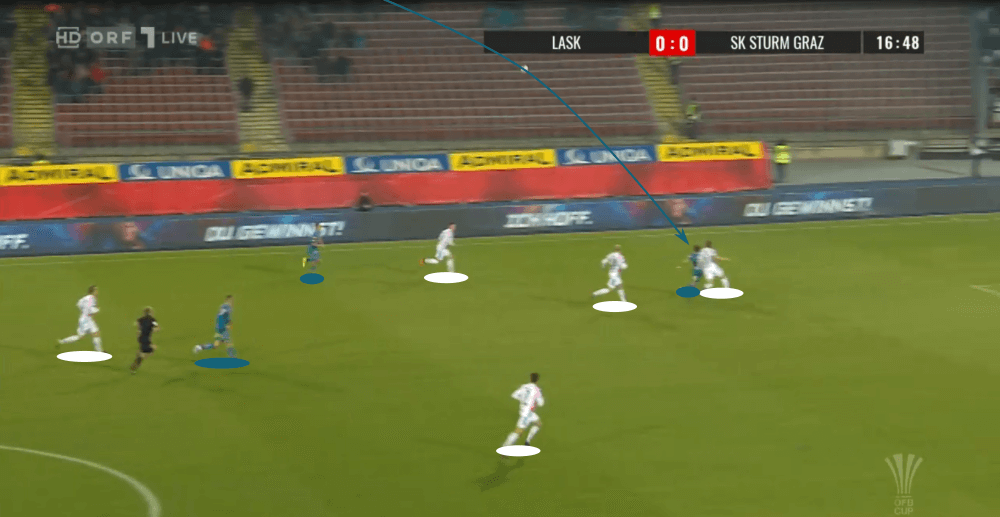
Husein Balić
In this winter transfer window, LASK Linz were able to sign one of the most promising talents in Austria in Husein Balić. The Austrian joined them from St. Pölten and made in this match his debut for LASK as he replaced in the 63rd minute the left-winger Rieser. But Balić didn’t just stay on the left-wing but instead showed some interesting movements. Since he joined his new club just in the last month and now made his debut in a competitive match it was clear that he wouldn’t harmonize perfectly with his new teammates.
Anyways, he showed that with his incredible pace he perfectly fits into the vertical and offensive style of play of Linz who became better and better after his substitution. He provided his teammates vertical passing options and also made deep runs to receive through passes as in the example below. Besides, notice where he starts his run and receives the pass as a left-winger.
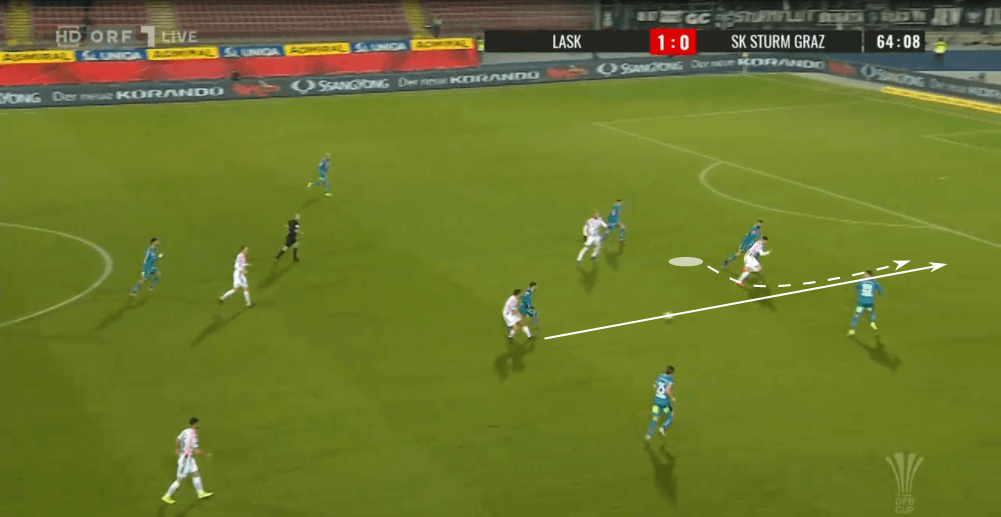
Logically, you expect from a player who comes onto the pitch after about one hour, that he plays really active since he should have more power than the other players on the field. The 23-years-old did exactly so and made deep runs as in the situation above or opened up passing lanes for his teammates as shown below. Also, we can see here how flexible LASK is in the high areas as the central striker Klauss is positioned in the right wide-area while the left-winger Balić opens up the passing line to the right-winger Goiginger who makes a deep run in the centre.
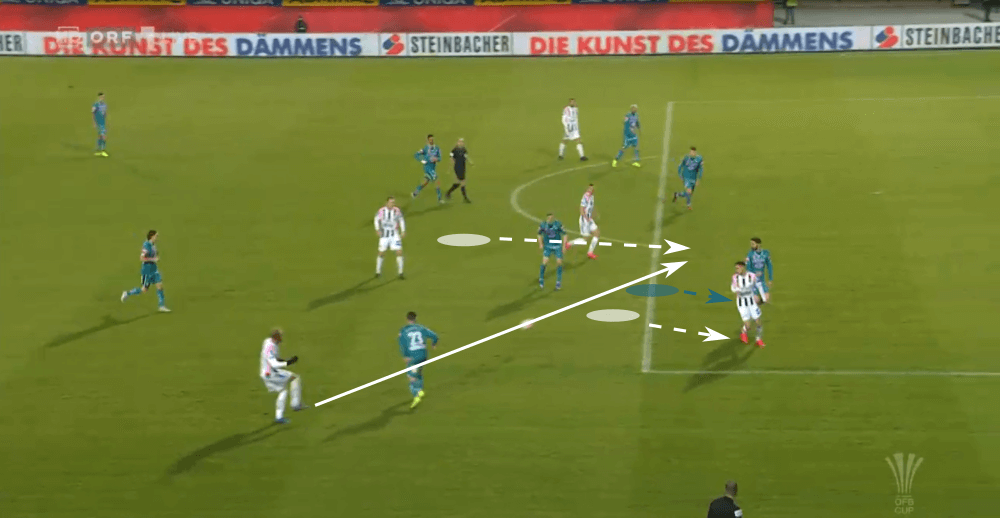
The 23-years-old Austrian winger showed a great performance on his debut and showed that he can really help his new team. He was active and permanently wanted to get on the ball and be involved in the game. In the injury time, he even scored his first goal for LASK as he dribbled down the left-wing past all his opponents to then score with a strong shot into the near corner. He saw that the goalkeeper Siebenhandl expected a low ball into the centre to his teammates, but Balić saw that coming and scored the deciding goal.
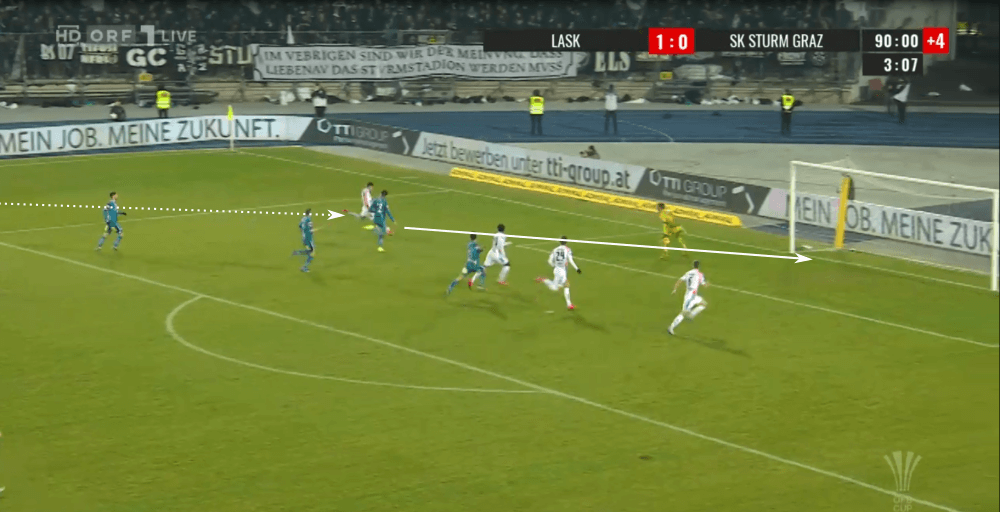
Conclusion
All in all, it was a quite disappointing performance of both teams as Sturm Graz only focused on the long balls which almost never worked off while LASK wanted to dominate the game, but they also didn’t play as well as they already have shown in this season. The most positive aspects of this game for Linz were clearly that their (counter-)pressing worked off that well and the solid debut of Balić.
Sturm will face next weekend Mattersburg in the Austrian Bundesliga while Linz will play against RB Salzburg what will be the duel between the league leaders (Salzburg) and the second-placed team in the Austrian Bundesliga (LASK Linz).





Comments